James Leggio
Living as we do now in the midst of an opioid epidemic, it may be illuminating to look back at another time when morphine and other opiates were all too freely available. In the nineteenth and early twentieth centuries, they could be readily obtained, usually from pharmacies, with often loosely provided prescriptions, among other sources.
As David T. Courtwright says in his book Dark Paradise: A History of Opiate Addiction in America (2001), “Doctors were impressed with the speedy results they got. It was almost as if someone had handed them a magic wand.” A physician’s account, quoted from the late 1870s, says that in treating a man injured in a bar room brawl, “I gave him an injection of morphine subcutaneously of ½ grain. This acted like a charm, as he came to in a minute from the stupor he was in and rested very easily.” By 1895 an epidemic had taken hold, and as Erick Trickey writes in a recent article for Smithsonian, “Before 1900, the typical opiate addict in America was an upper-class or middle-class white woman.” Such a woman, in other words, as Emma O’Neill, mother of the playwright (and model for his character Mary Tyrone), who became addicted at the time of Eugene O’Neill’s birth in 1888.
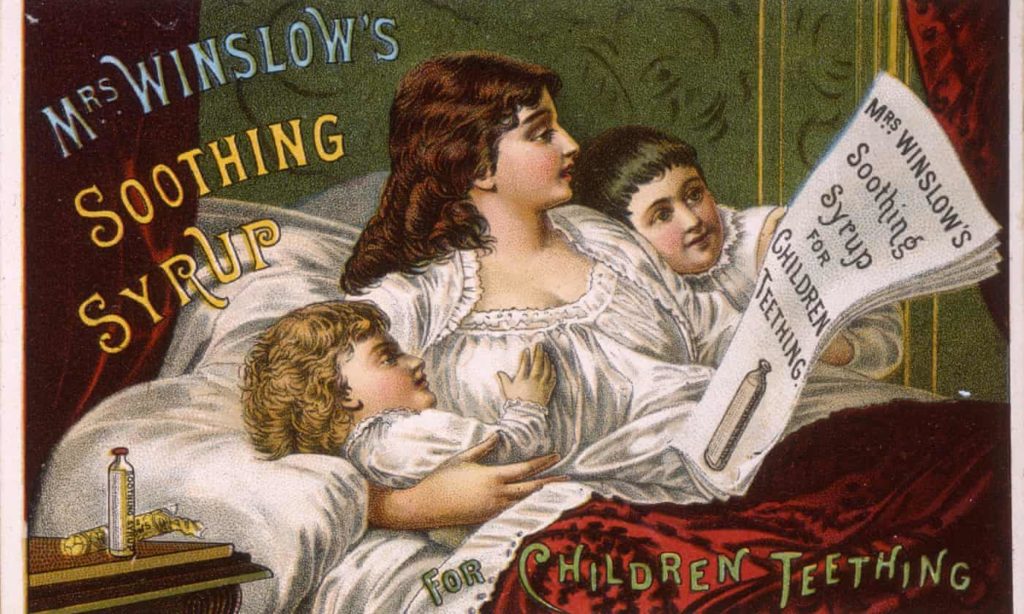
To get a fuller idea of just how insidious, and how utterly commonplace, that epidemic of overuse really was, we need only note the disturbing inclusion of opiates in popular packaged remedies intended for children. One especially obnoxious advertisement for a morphine-tainted “calming” formula, called Mrs. Winslow’s Soothing Syrup, available throughout the latter decades of the nineteenth century, presents doping one’s children as virtually a parental obligation. An item in the New York Times, dated October 5, 1861 (p. 5), carries this chilling testimonial:
We have a child three months old, which has screamed almost incessantly with a spasmodic affection of the bowels, so that we had despaired of ever raising it. Its stomach was sour, bowels deranged, and almost every symptom was unfavorable, until we obtained a bottle of the SOOTHING SYRUP, which acted like a charm, immediately became quiet, and now manifests every symptom of improvement and comfort. It is now as good as a little kitten, playful and smiling, and seems entirely well. All of which we ascribe to the use of MRS. WINSLOW’S SOOTHING SYRUP.
Apparently, reducing an annoying infant (referred to as “it”) to a “little kitten” through a concoction made with morphine and alcohol was thought to be a good idea. Indeed, another ad for the same product claimed “A Mother’s Kiss Is Not Half So Soothing to Baby as Mrs. Winslow’s Soothing Syrup” during teething. Dangerous, sentimental drivel like this, playing on the fears and trials of young parents, gives some context to Mary Tyrone’s anguish, since her addiction grew out of a postpartum fix.
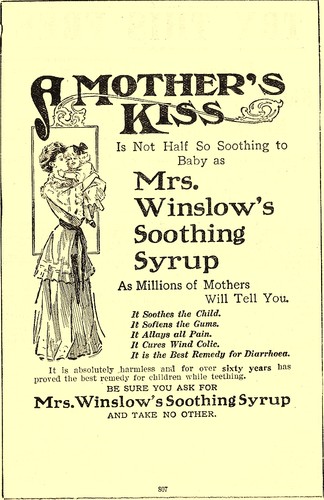
In the United States, it was not until the passage of the Pure Food and Drug Act in 1906 that manufacturers were required to indicate on the label any ingredients considered “dangerous” or “addictive” in their products. And then, in 1914, came the Harrison Narcotics Tax Act. As James Nevins describes the act in his article “The Strange History of Opiates in America: From Morphine for Kids to Heroin for Soldiers,” in The Guardian, it was a breakthrough in drug control, but a flawed one: “While physicians were supposedly excluded if the drugs were deemed medically necessary, the law severely limited the ability of doctors to prescribe opiates. The act singled out addiction as a moral failing, not a medical disease, which made it nearly impossible for physicians to treat anyone with an opiate dependence.”
There is an unfortunate ambivalence here. On the one hand, opiate addiction was finally coming to be understood as a medical problem requiring legal substance control; but on the other, drug use was still often seen as a moral weakness rather than a chemical dependency.
Long Day’s Journey into Night (1941), set in 1912, two years before the Harrison Act, revisits a transitional time when this ambivalence — medical problem versus moral failing — remained very much in play. Morphine abuse, though just beginning to come under legal control, was still often mislabeled as an issue of personal morality and “will-power.”
Still, the playwright’s minute examination of drug dependency in that era tried to finally drive a stake into the heart of the old Victorian fiction that unregulated morphine could be good for you. O’Neill offers a detailed case study in the modern medical understanding of how quickly an addiction can become established, and how easily a relapse can occur, even after seemingly successful treatment. Indeed, these days Journey has become a focus for therapeutic discussion by some rehab support groups. And the Mayo Clinic, in collaboration with the Guthrie Theater, has used the play as a teaching tool.
“a special kind of medicine”
Just before writing Long Day’s Journey into Night, O’Neill began to explore changing attitudes toward drug use in his immediately preceding play, The Iceman Cometh (1939), also set in 1912. In Act 1 of Iceman, the character Larry Slade, who calls himself “a philosophical drunken bum,” has this to say as he tries to dissuade young Don Parritt from asking him for guidance:
I feel you’re looking for some answer to something. I have no answer to give anyone, not even myself. Unless you can call what Heine wrote in his poem to morphine an answer.
(He quotes a translation of the closing couplet sardonically.)
“Lo, sleep is good; better is death; in sooth,
The best of all were never to be born.”
As the stage directions tell us, at these words Parritt “shrinks a bit frightenedly.” As well he might. It’s still early in Act 1 of a very long four-act play, and we’re already at the brink of the abyss. Toward the end of the act, Hickey’s long-awaited arrival will not improve on Larry’s prognosis.
Morphine (taken by external route, in his case) was prescribed to the German poet Heinrich Heine (1797–1856) during the last dozen years of his life by Dr. David Gruby, to relieve the pain of neurosyphilis. Heine knew whereof he spoke. Clothing a medical issue in literary garb, the poem plays two mythological brothers against each other: Morpheus, god of sleep and dreams (and the origin of the word morphine); and Thanatos, the personification of death. The quoted translation is by Emma Lazarus, which reads in full:
Marked is the likeness ’twixt the beautiful
And youthful brothers, albeit one appear
Far paler than the other, more serene;
Yea, I might almost say, far comelier
Than his dear brother, who so lovingly
Embraced me in his arms. How tender, soft
Seemed then his smile, and how divine his glance!
No wonder that the wreath of poppy-flowers
About his head brought comfort to my brow,
And with its mystic fragrance soothed all pain
From out my soul. But such delicious balm
A little while could last. I can be cured
Completely only when that other youth,
The grave, pale brother, drops at last his torch.
Lo, sleep is good, better is death—in sooth
The best of all were never to be born.
This is the text as O’Neill knew it. The “wreath of poppy-flowers” points directly to the opium-den-like “pipe dreams” of the denizens of Harry Hope’s bar and the dreams’ collapse, by Hickey’s doing, at the end of the play. Moreover, the translation portrays the sensual, seductive allure of morphine-induced oblivion, which “with its mystic fragrance soothed all pain from my soul.” And, ominously, it emphasizes how ephemeral the effects of the “delicious balm” actually are, and therefore how much “better is death” — understood as the only thing by which “I can be cured.”
The fateful introduction of Heine’s “Morphine” into Iceman sets the stage for the unfolding drug theme in O’Neill’s later play. Hickey himself picks up the theme of induced, if still “poetic,” oblivion when later in Act 1 he tells everyone in Harry Hope’s dead-end bar that he’s quit drinking alcohol for good, and adds:
No, boys and girls, I’ve never known what real peace was until now. It’s a grand feeling, like when you’re suffering like hell and then the Doc gives you a shot in the arm, and the pain goes, and you drift off.
(His eyes close.)
You can let go of yourself at last. Let yourself sink down to the bottom of the sea. Rest in peace. There’s no farther you have to go. Not a single damned hope or dream left to nag you.
It’s quite a florid speech for a dilapidated bar room. “The bottom of the sea,” where dead sailors lie in sunken ships, has never sounded more alluring, nor has the funereal epitaph “Rest in peace,” tolling the same death knell that Heine had. (In this video of the play, Hickey’s speech comes just after the 57-minute mark.) What should perhaps have been a medical alert is instead a morbid rhapsody.
When we arrive at Long Day’s Journey into Night itself, opiates continue to be mistakenly described, now by Mary Tyrone, as a healthful medical intervention bringing peace and comfort. Her addiction had begun when she was introduced to morphine, around 1888, by a quack doctor who unwisely injected it as a quick fix for unusually intense postpartum pain. As Mary says in a dreamy speech to Colleen, her housemaid:
It’s a special kind of medicine. I have to take it because there is no other that can stop the pain — all the pain — I mean in my hands. . . .
(Dreamily)
It kills the pain. You go back until at last you are beyond its reach. Only the past when you were happy is real.
(She pauses — then as if her words had been an evocation which called back happiness she changes her whole manner and facial expression. She looks younger. There is a quality of an innocent convent girl about her, and she smiles shyly.)
In this scene, the housemaid says Mrs. Tryone seems to have “a drop taken,” so unusually wandering is her speech. Mary must equivocate after the slip of the tongue about “all the pain” — meaning her current medical, familial, and psychological state — and pretend she’s merely talking about her arthritic hands. This is Mary’s drug-driven performance dynamic in a nutshell: the back-and-forth between accidentally evidencing altered behavior and then giving voice to immediate, defensive evasions.
How to handle her slippery vacillation between dosing and self-defense is the main problem to be solved by anyone who undertakes the role.
Playing Mary Tyrone Onstage
Mary, who is fully sober only in the play’s relatively idyllic opening scene, injects herself with morphine three (or possibly four) times during the remaining course of the play: (1) when she goes upstairs, after breakfast; (2) when she again goes upstairs, after lunch; (3) upon her return to the house with Colleen, the housemaid, after they’ve picked up the package of morphine from the drugstore (at least as this scene has sometimes been staged); and (4) when she goes upstairs for the last time, after refusing dinner. The drama arises not only from the upsets and accusations that send her escaping to the upper floor for each hit, but also the effect that the increasingly evident doses have on the three men when she comes down again, in each instance farther gone than the last. There is no escaping the cycle: every scene must be understood as pre-dose or post-dose or both.
When speaking with her family, therefore, Mary must walk a high-wire tightrope between asserting calm, reasonable, offended denial of any wrongdoing, and displaying the ever more obvious symptoms that the men see developing before their eyes. Playing Mary means acting out each bobble, dip, and vertiginous misstep as she walks the tightrope, with each death-defying step, between feigned sobriety and actual impairment.
Many distinguished performers have played this role and found their own way of acting out Mary’s predicament. Their varying approaches can be traced through a number of major productions. (Links to sample film clips are included here, when possible.)
Katharine Hepburn (film adaptation, directed by Sidney Lumet, 1962). In this clip, Katharine Hepburn as Mary speaks about the “special kind of medicine” with the housemaid. In this film, Sidney Lumet staged the action so as to indicate Mary took a dose of morphine immediately after returning from their trip to the drugstore — that is, just before this scene — though O’Neill’s usually explicit stage directions do not directly indicate this. Nonetheless, we see a disoriented Mary fall on the floor as she calls herself a “lying dope fiend” who “hasn’t taken enough,” but is then prevented from taking more, for the moment, by the return of James and Edmond. In this and other more animated scenes, Hepburn’s very personal movie-star style is riveting, to the point of dominating the menfolk much of the time, though with her characteristic lilting vocal inflections and faux-genteel manner she does often seem to have wandered in from a Tennessee Williams play. Still, the quivering lower lip, the moist eye, and the unsteady tone of voice suit the character well, managing to become instruments of aggression as well as self-defense. To some extent, however, her work in this beloved performance is made to seem perhaps just a bit over the top by the visual style imposed by director Lumet and cinematographer Boris Kaufman; the deep black-and-white shadows, the high-key contrast, and the ostentatiously composed geometry of the interior shots give the film the now-dated feel of a lurid 1940s film noir underworld drama. And Lumet’s exaggerated reaction shots begin after a while to feel almost manipulative, as if it wasn’t already clear enough how we’re supposed to feel. It’s almost always a mistake to thus highlight O’Neill’s penchant for sheer melodrama, inherited from his barnstorming father, since the typical emotional scale in his plays is already so heightened. Somehow, Hepburn survives.
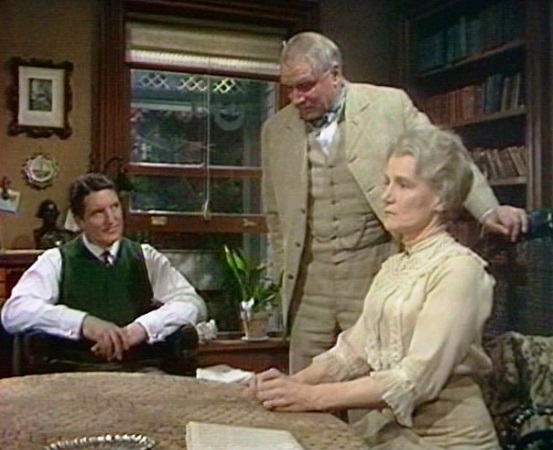
Constance Cummings (ITC television film of the National Theatre, London, production, directed for the stage by Michael Blakemore and for television by Peter Wood, 1973). Some performers become more resolved under the influence as the doses accumulate, as Constance Cummings notably does. Although Laurence Olivier won an Emmy for his portrayal here of James, he can’t avoid a certain amount of accent slippage — a classically trained British actor trying to capture the “American” theatrical accent of a deeply “Irish” former matinee idol who once had “a brogue you could cut with a knife,” a dauntingly multifaceted vocal impersonation that succeeds only fitfully. His variability of speech somewhat diminishes his effectiveness as a foil to Mary. Her greater certainty of speaking voice, mirroring her steely determination not to be pushed around, keeps her in charge most of the time. She becomes a Queen of Denial as she bats back the men’s accusations, though she and they all know them to be true.
Ruby Dee (ABC television production, directed by William Woodman, 1982). In the opening scene with Earle Hyman as James, Ruby Dee embodies the briefly relaxed spirit of the day’s early morning, before the first hints of suspicion arise. Performing Long Day’s Journey into Night with an all-black cast could have proven controversial, but only slight adjustments to the text were required to turn an Irish American family into an African American family. Though the textual changes are few, nonetheless questions of cultural heritage, social position, and family history take on new and rewarding resonance because the actors are who they are and fully inhabit their roles. In this nontraditional casting, the family dynamic is as convincing as ever while, to the relief of some of us, getting outside of O’Neill’s habitual and sometimes limiting “Irishness.”
Bethel Leslie (film version, directed by Jonathan Miller, of his London and New York stage production, 1987). Bethel Leslie performs, startlingly, just the way Jonathan Miller described her in a subsequent interview included with the DVD: “She’s not a victim. She’s one of those wonderful lace-curtain Midwestern Irish women who run their households through being a victim. It’s the way in which they tyrannize their family; a flinty, difficult, little Catholic Irish lace-curtain suburban Indiana bitch.” This is the notorious production in which Miller relied on the technique of overlapping dialogue, famously associated with the screwball film comedies of Howard Hawks, notably His Girl Friday (1940). Miller’s production is revisionism par excellence, from the casting of veteran comedian Jack Lemon as James to the breakneck pace of line delivery, demystifying Orestia-like family tragedy into domestic farce. But it works. Lemon, Kevin Spacey, and Peter Gallagher bravely resist Leslie’s “tyranny,” but generally bow to her often undervalued force of character. Still and all, though, Miller’s stated aim here, only half in jest — “subverting . . . a masterpiece” — does lead him to somewhat obscure the point of one of the playwright’s major visual clues: when Mary finally descends the stairs in Act 4, the stage directions tell us, “Her eyes look enormous. They glisten like polished black jewels.” In the interview, Miller dismisses the author’s poetic simile as “absolute drivel” and “twaddle” — ignoring the simple fact that Mary’s eyes are indeed literally “black” because of her morphine-dilated pupils, which Jamie noticed in Act 2, after her first dose, and reproached her for, saying “Take a look at your eyes in the mirror.” O’Neill’s grasp of the user’s visible symptoms was quite secure.
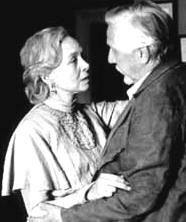
Martha Henry (CBC television production, directed by David Willington, 1996). Martha Henry makes for an unusually soft-spoken Mary, more annoyed than alarmed at scrutiny by her family. Being under the influence softens the bouts of recrimination as she adopts a somewhat soothing, rather than defensive, tone when the family presses her too closely. She is so agreeable that the men lose heart, unable to press the attack against such a seemingly defenseless target. She shames the fight out of them. Yet this is, in its way, one of the loveliest of productions, precisely because of its intimacy and restraint. Its unforced naturalism seems to better convey what Johnathan Miller said he wanted to do — show how family members actually talk to each other. It is, throughout, conversational rather than rhetorical.
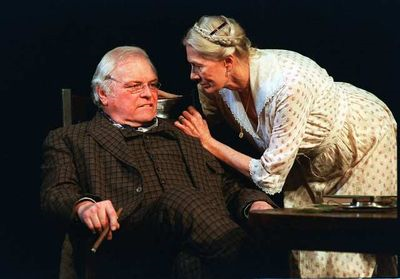
Vanessa Redgrave (Plymouth Theatre, New York, directed by Robert Falls, 2003). Vanessa Redgrave gives a different twist to domestic conflict. She conspires with her co-star, Brian Dennehy, to bring out the still-strong charge of sexual tension between James and Mary Tyrone, thereby insidiously deflecting James’s attention from their battle of wills over her emerging symptoms. As for her skillful handling of the character’s mood swings, one can do no better than quote Ben Brantley’s review of Redgrave’s performance, in the New York Times: “Mary’s manner of dealing with her men becomes increasingly divided, as do her allegiances. The spotlight of response she turns on the others keeps changing its colors, from fretful solicitude to harsh reproach, from the sly self-concealing lies of a confirmed drug addict to raw self-revelation. What’s most remarkable is the fluidity with which these shifts occur and how surprising they remain throughout the evening.”
Laurie Metcalf (Apollo Theatre, London, directed by Anthony Page, 2012). In one of the most plainspoken and non-actory interpretations, Laurie Metcalf brings an unfussy, modern sensibility to this story of 1912. In this her work may remind us of what Sigmund Freud wrote in Studies on Hysteria (1895) about the goals of his “cathartic” (early psychoanalytic) treatment, which he phrased here as he might explain them to a patient: “. . . much will be gained if we succeed in transforming your hysterical misery into common unhappiness.” Of course, hysteria is now an outdated, hopelessly misogynistic term. But in making a more modern diagnosis of Mary, Metcalf more directly conveys the character’s sheer everyday sadness, moving her away from what were still considered hysterical outbursts in 1912, and toward the honest portrayal of “common unhappiness.”
Jessica Lange (Roundabout Theatre, New York, directed by Jonathan Kent, 2016). Jessica Lange portrays a woman more long-suffering, soft, and betrayed. This set of clips briefly shows her scene with the housemaid, discussing her “medicine,” as well as her recriminations with James about Edmund’s birth. Lange wrote a Foreword to the Critical Edition of Long Day’s Journey into Night published by Yale University Press. There she astutely identifies the contradictions impelling the character: “One heroin addict I talked to when I was preparing to do the play described how it felt like being wrapped in a warm blanket. I imagine that’s what Mary is looking for. But like many addicts, she is also a master of deceit, a champion liar. . . . Mary is also a master of manipulation. She controls every moment she is on stage, and at the same time she is barely in control of herself.”

Lesley Manville (BAM Harvey Theater, Brooklyn, directed by Richard Eyre, 2018). Among the most remarkable interpretations has been offered by Lesley Manville (poorly represented by this brief commercial trailer). She is perhaps the most wounded, vulnerable, and jittery Mary Tyrone in recent memory. What most set her performance apart, though, was her solution to the problem of Mary’s late entrance in Act 4, which has been awaited with dread by the three men, who fear her coming downstairs to invade their sanctuary with her full-blown delirium. At this climactic moment, Manville silently swoops down the staircase, at headlong, reckless speed, her feet barely seeming to touch the stairs, as she trails the yards of wedding veils that billow behind her. It is an astonishing effect that transforms the play. Manville has turned what is usually treated as the deadly slow apparition of a looming ghost into her character’s only true moment of dynamic, physical energy. We come to feel the heady, intoxicating sense of liberation offered by her obliviousness to her surroundings.
Manville thus highlights what makes Long Day’s Journey into Night so disturbing: her moment of elated joy in her delusional “Mad Scene,” as Jamie calls it, shows just how piteously unreal are the everyday dreams, hopes, and self-delusions by which we congenitally unhappy humans try to comfort ourselves.
As Charles McNulty wrote in his review for the Los Angeles Times: “Manville’s last scene closes the circle of the play’s meaning. Released into a morphine haze, Mary becomes a phantom doomed to roam in a purgatory of regret. O’Neill’s tragedy wounds without providing the salve of catharsis.”
Emma O’Neill’s Recovery
As is widely known, Emma O’Neill did in fact recover from her addiction — in the course of spending time in a convent, in 1914 — and remained drug-free (except for a brief relapse after a mastectomy) for the rest of her life. Is it legitimate to ask why her playwright son chose to focus exclusively on her tragedy and not mention her later triumph?
A play by Ann Harson tells a fictional story of Emma O’Neill’s recovery, as the details of the biographical episode are not known. In Miles to Babylon (2010), Mrs. O’Neill returns to the convent school of her youth and, through a mixture of revived faith and tough love, finally kicks the habit. What may be unsatisfactory in the play is that it harkens back to the attitudes of the turn of the twentieth century, when addiction was considered a moral failure rather than a chemical dependency, and recovery was thought a matter of summoning the requisite “will-power” or, perhaps, faith healing. (Of course it was not until the 1960s that methadone was introduced, the first major attempt to treat opioid addiction with a maintenance “substitute” longer-acting than the short-term addictive drugs like heroin.) In Emma O’Neill’s case, we simply do not know what allowed her treatment to be successful. Her recovery does appear to have been related to a revival of her belief during her stay in the convent. But there is also the known factor of a change in the laws in that same year, 1914, making morphine a much more strictly controlled substance, and much harder to come by without a properly licensed physician’s documented prescription. Perhaps there was more than one motive at work in her sudden need to get better at that moment, after decades of addiction.
The fact that her recovery was apparently at least in part faith-based may bring to mind one of the playwright’s worst artistic failures. He had taken a religious approach to physical illness in his disastrously received Days Without End: A Modern Miracle Play (1933), wherein a blatantly miraculous scene set in a church exorcises the hero’s Freudian doppelgänger and at the same time saves the life of his spouse, Elsa, who has been dying of pneumonia. Such residual strains of Irish Catholicism and embarrassingly sincere melodrama remained somewhere in the author, as they did within James Joyce’s Stephen Dedalus, except that they were, as someone says of Dedalus, “injected backwards.” O’Neill’s incipient taste for the maudlin, which breaks out in Days Without End, could damage some of his best plays. At its worst, unless carefully avoided, extreme emotionalism leaves certain works vulnerable to a response something like the memorably derided 1988 New York production of Strange Interlude (1928), in which the audience laughed openly at lines meant to be deadly serious.
Perhaps it was wise to avoid the language of overtly religious rhetoric and fervent emotional excess at this late point in the playwright’s career, and not write about his mother’s recovery in a Roman Catholic convent at all. To draw a comparison, a self-consciously “religious” late play coming from this onetime Catholic writer would have invited the accusation of self-betrayal that Friedrich Nietzsche had once hurled at the composer Richard Wagner. With Parsifal (1882), Wagner had turned his last opera into a ceremonial Last Supper that “redeemed the redeemer” and cured Amfortas’s chronic wound with a Christian benediction. Seeing this, Nietzsche jeered that after a long and glorious career of artistic daring and ideological freedom, in the end Wagner had merely “fallen sobbing at the foot of the Cross.”
A Misbegotten Son
For whatever reason, O’Neill chose not to write explicitly about his mother’s recovery. But he did come to feel that he hadn’t quite done right by his older brother in Long Day’s Journey. So he continued the Tyrone family history, in A Moon for the Misbegotten (1942–43), by skipping ahead eleven years to the declining days of Jamie (now called Jim), and in a way that invoked Jim’s mother, Mary.
Toward the end of Long Day’s Journey, while they awaited their mother’s final descent of the stairs, Jamie had said to Edmund:
. . . this time Mama had me fooled. I really believed she had it licked. She thinks I always believe the worst, but this time I believed the best.
(His voice flutters.)
I suppose I can’t forgive her — yet. It meant so much. I’d begun to hope, if she’d beaten the game, I could too.
(He begins to sob, and the horrible part of his weeping is that it appears sober, not the maudlin tears of drunkenness.)
In 1914, Emma O’Neill, the template for Mary Tyrone, had indeed “beaten the game” and recovered from her addiction. And Jamie’s hope that “I could too” was for a time fulfilled. In A Moon for the Misbegotten, Jim says that for the last two years of his mother’s life, he had remained sober, too. In her old age she needed Jim to take care of her, with her husband dead and younger son off starting a family of his own. She had always hated Jim’s drinking, and he gave it up for her sake because he loved her. But as she lay dying, falling suddenly ill during their trip to California, the impending loss was too much for him, and he again lapsed into heavy drinking. Unfortunately, she briefly woke from her coma to see her elder son sodden again, and he was mortified, knowing that she died having lost faith in him. That traumatic event was the incitement to Jim’s self-damning last-act speech in Moon, about bringing her body home by train for burial and staying drunk all the way, and ever since. At one point in it, he recites a sentimental old song: “And baby’s cries can’t waken her in the baggage car ahead.” No soothing baby syrup for him.
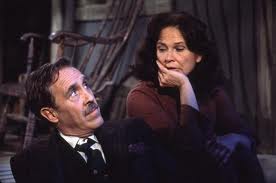
Still, even referring to such a disturbed individual, the choice of the word misbegotten in the play’s title can seem problematic. What is “misbegotten” about Mary’s son? The Nicene Creed, written by a committee of church officials in 325 CE, asserts that the son of the Virgin Mary was “begotten, not made” (meaning he was of one substance with his heavenly father), familiar words to a Catholic that I suspect come ironically into play here. In one of its senses, “misbegotten” means deformed, misshapen, or (literally) mis-conceived — burdened at conception by a flawed chromosomal inheritance. The science of genetics thus allowed a new twist on being “of one substance” with one’s father; that is, by carrying his genetic defects. Such a defect as, perhaps, an inherited predisposition toward substance abuse, as manifested in a father’s lifetime of hard drinking as well as, of course, a mother’s decades-long addiction.
Mary Tyrone had once, in Journey, wished that she might accidentally take an overdose strong enough to end her life, but which, being an accident, would allow the Virgin Mary to forgive her. Jim Tyrone, overwhelmed by self-loathing, craves a similar kind of self-euthanasia, as he goes about deliberately drinking himself to death. For one so misbegotten, however, as Heine wrote about morphine, “The best of all were never to be born.”
(October 2018)
